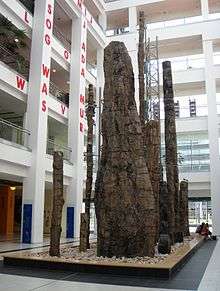Chemnitz petrified forest

The Chemnitz petrified forest is a petrified forest in Chemnitz, Germany.
Most of the trunks are exhibited in the Museum of Natural History in the Chemnitz department store Kulturkaufhaus Tietz (DAStietz), including slices of trunks with polished edges. A small collection can be seen also on Zeißstraße. In 1996 another petrified trunk was found in the Hilbersdorfer corridor. Since April 4, 2008 searches on a plot on the Frankenberger street found more trunks. There researchers discovered Arthropitys bistriata, a previously undiscovered type of Calamites, giant horsetails that are ancestors of modern horsetails, with multiple branches.[1] This exceptional find received the 2010 Fossil of the Year award of the German Paleontological Society.[2] It was integrated into the permanent collection.
History

Petrified trunks of tree-like, primeval plants were repeatedly discovered in 1737 at Hilbersdorf, today a district of Chemnitz, during excavation work. In the mid-18th century, gemstone prospector David Frenzel (1691-1772) found numerous examples of this wood in the mountains near Chemnitz. One of his 1751 finds is one of the few petrified wood specimens still possessing its roots. Later a collector, the Hilbersdorf contractor Güldner, bequeathed some of the petrified logs to King Albert Museum in Chemnitz. The first director of the Museum, Johann Traugott Sterzel, took over the investigation of the findings. The Sterzeleanum in the museum (the petrified forest display) is dedicated to him.[3]
Creation of the petrified forest
The petrified forest was formed in connection with the eruption of the Zeisigwald volcano in the lower Permian and dates back about 291 million years.[4] The Chemnitz fossil find site largely contains strains of Cyatheales (tree ferns and giant horsetails). The tree-like plants were uprooted or snapped off by the blast of the eruption, much like the trees caught in the 1980 eruption of Mount St. Helens. The trunks were then covered with hot tephra at 80 to 100° C. In the following millions of years, the silicic acid included in the tephra ensured the fossilization of Permian plants, preserving them until today.
References
- ↑ Ronny Rößler; Zhuo Feng; Robert Noll (2012), "The largest calamite and its growth architecture - Arthropitys bistriata from the Early Permian Petrified Forest of Chemnitz", Review of Palaeobotany and Palynology (185): 64-78, doi:10.1016/j.revpalbo.2012.07.018
- ↑ Fossil of the year award, German Paleontological Society
- ↑ A forest of precious stones – given by volcanoes – the Sterzeleanum, Museum of Natural History, Chemnitz, retrieved 2013-05-08
- ↑ Senckenberg Gesellschaft für Naturforschung Chemnitzer Wald ist 291 Millionen Jahre alt
Further reading
- Ronny Rößler (2001). Der versteinerte Wald von Chemnitz [The petrified forest of Chemnitz]. Museum für Naturkunde Chemnitz. ISBN 3-00-007446-5.
External links
| Wikimedia Commons has media related to Petrified Forest Chemnitz. |
- Official website (German)
Coordinates: 50°49′51″N 12°55′22″E / 50.83083°N 12.92278°E